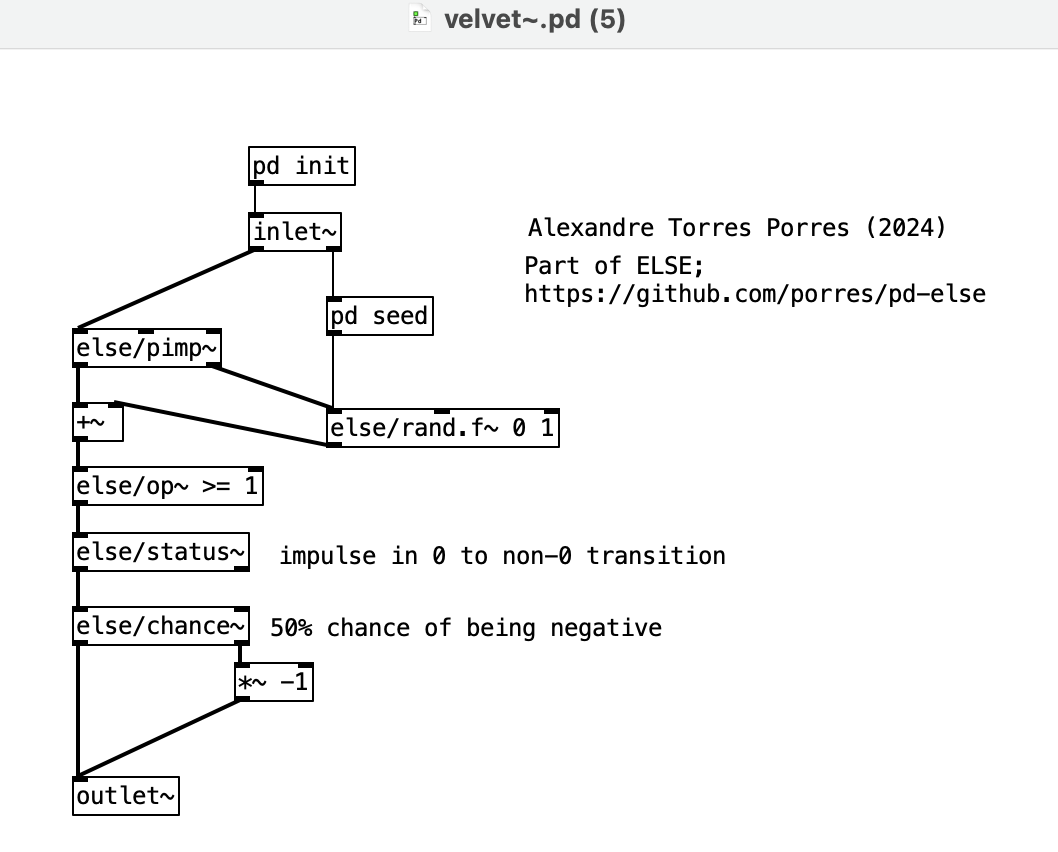In Pd of course, anyone? 
-
looking for velvet noise generator
-
@porres here's another simpler-to-implement type described in the paper - "totally random noise"
total-velvet.zip -
there is a good description here: https://acris.aalto.fi/ws/portalfiles/portal/13412521/applsci_07_00483_v2.pdf
it seems similar to dust2 in supercllider (and I ported that to ELSE already)
-
@porres the first version I posted is what is described in that paper. If you look at figure 1a you can see that there is 1 impulse randomly placed within a regular interval (which is shown by the red dashed lines in the figure).
-
It seems that the original version of the velvet noise generator finally didn't work hundred percent correctly (see the unresolved problems mentioned above). So here's a slightly different algorithm ... velvet-noise.pd
This one doesn't use any externals, in fact not even [expr~]. Hope it works!
Or is there another solution for this in the meantime?
-
nice idea!
here's a version based on it using expr~ and addition instead of subtraction
pure-velvet-noise-2.zip -
nice, I still have this in my list but I never get to it... I might check this all and include a compiled object in ELSE for it right now...

@seb-harmonik-ar I still don't know why you reset the phase on the [phasor~]
-
@porres it's just to give the user more control.. what if the user wants to reset the time period for triggering an impulse?
I included a version in my own library as velvet~ where it's driven by an external phasor (as well as controls for temporal and impulse bias), and just getting the precession to add with[rzero~ 1] | [wrap~] -
here's my 'ELSE' version. No phase output, no phase reset, signal input and able to set seed

I still wanna check the algorithm, I don't really get it
-
@porres I leave the explaining to @seb-harmonik.ar, but I'm wondering if further optimizations may be possible:
-
Do we really have to scale the white noise going into [samphold~]? I don't think so.
-
Couldn't we use just one noise generator for both random variables? I mean, they are sampled at different times, so shouldn't this guarantee an uncorrelated outcome anyway? Not sure about that ...
-
-
ok, I see that you're going for period transitions in the [phasor~], well, this can be drastically simplified with [else/pimp~]! Let me think
-
So, what we need is just an impulse randomly placed within period, this could be done by modulating the phase of [pimp~] quite easily!
-
nah... it does output impulses more frequently...
-
what I don't get is why you need to add to a multiplication of the frequency and the sample rate period, can you explain that @seb-harmonik.ar ?
-
New ELSE version
Just a single noise source, no [expr~] and no copysign, which might be expensive and also the way I'm doing it now has "real zeros". I was very annoyned that the other version had a bunch of "-0" (minus zeros) values!

-
@porres Ah, now I see the problem ... (so I'll try to explain anyway)
By multiplying the frequency with 1/SR you get the phase increment of the phasor. Since there is exactly one sample in each cycle where the sum of the current phase and the increment gets bigger (or equal to) 1, you get the impulse. Now all you have to do is to randomize the phase to get the impulse at a random position.
I'll have to take a look at your new version ... (Still I don't think the noise scaling and [+~ 0.5] are necessary.)
Edit: Just noticed that you have ">" instead of ">=" in the [op~].
-
new version, seems more elegant to just use [pimp~] and use it to trigger a random number generator


-
This post is deleted!
-
This post is deleted!
-
Ok, a much simpler approach now, I believe.
Never liked using the samplerate to add an increment, and wrap~ and everything, so what we need is just being able to catch the transition above 1 and make it an impulse out of it, so [op~ >= 1] into [status~] solves that!

-
damn, I have so many tools in ELSE that generates impulses that even myself can forget what is the best to use sometimes. It turns out I just need [above~] for this... and [chance~] also needs seeding


